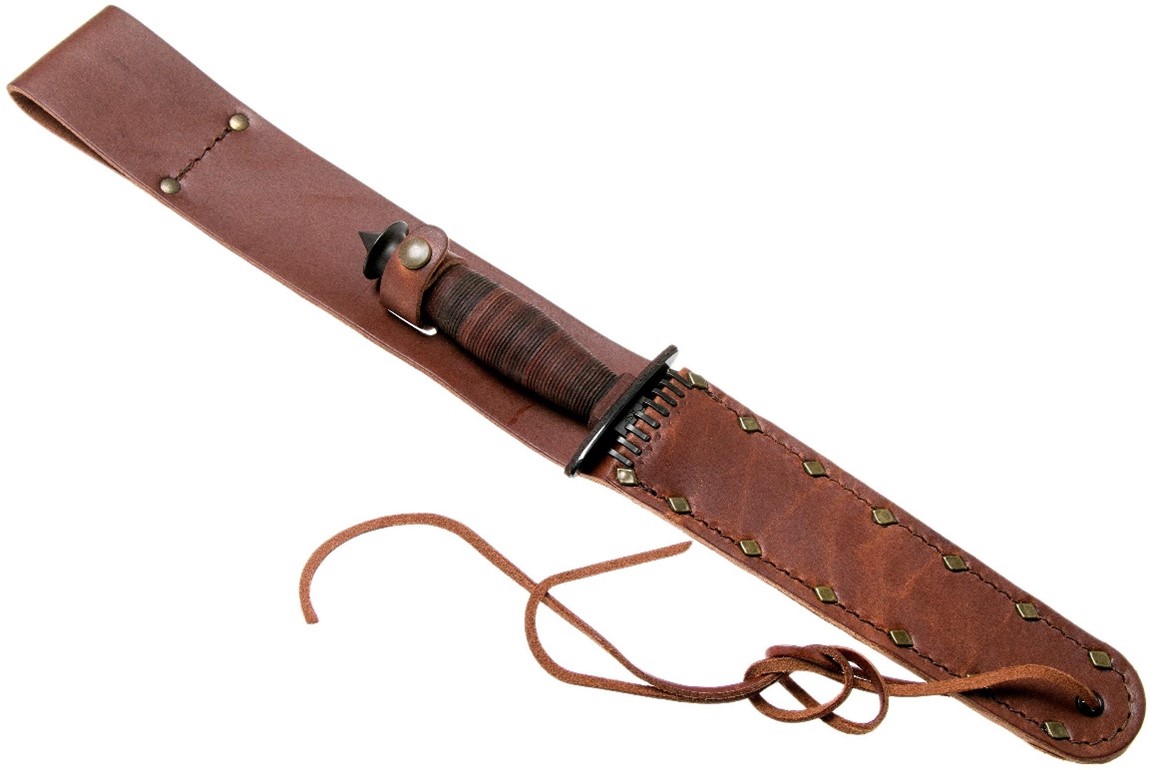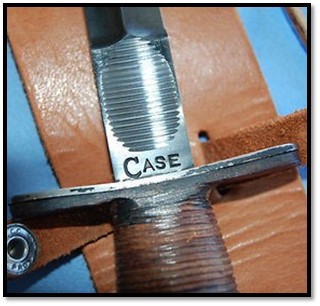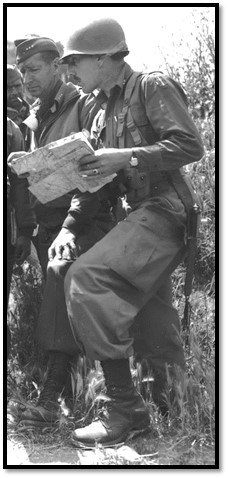By: Warren Gray
Copyright © 2023
“The…V-42 stiletto blade profile was designed to optimize penetration
on thrusting; it could easily penetrate a G.I. steel helmet and liner
with a single thrust. With its relatively thin, narrow blade, the
V-42 was designed from the outset for use as a fighting knife.”
— Wikipedia, 2022.
In 1942, the W.R. (William Russell) Case & Sons Cutlery Company of Bradford, Pennsylvania, less than four short miles from the New York state line, was awarded a U.S. Army contract to produce a close-quarters, combat dagger for the elite, First Special Service Force (FSSF, or 1st SSF) commando unit, based at Fort William Henry Harrison, near Helena, Montana.
The unit commander, Colonel Robert T. Frederick, age 35, personally approved the design, which was known as the Fighting Commando Knife, Type V-42 (indicating Version-1942). Many, 3,423 exactly, of these very special knives (including three prototypes) were ultimately produced, including an initial shipment of 1,750 daggers to the FSSF in November 1942. A further 70 knives sent to the U.S. Navy in February 1943 for use by the USS Omaha Landing Force and Armed Boat Party in the South Atlantic Ocean. An additional 1,600 knives were apparently delivered to the FSSF in three batches, during June, October, and November 1943. Some U.S. Army Rangers and paratroopers also acquired limited numbers of V-42s from FSSF stocks on an individual basis. Colonel Frederick personally carried one of three Case prototype daggers with a polished, steel finish into combat.
The First Special Service Force was originally created as a joint, U.S.-Canadian special operations unit, specifically to conduct winter warfare and sabotage operations in German-occupied Norway, Romania, or the Italian Alps. They were directly responsible to the Joint Chiefs of Staff, and they adopted the crossed arrows of the former Indian Scouts as their military branch insignia. The unit was activated on July 9, 1942, conducting its parachute training almost immediately. Using C-47 Skytrain aircraft, within two days of the soldiers’ arrival, they all became jump-qualified together, to enhance group morale and esprit de corps.

FSSF parachute training, 1942. Photo credit: U.S. Army.

FSSF silver-oxide jump wings and unit oval. Photo credit: www.captainstevens.com.
All FSSF members, regardless of nationality, wore U.S. Army uniforms with a red, spearhead patch on their left shoulders, bearing the white lettering: “USA – CANADA.” They wore brown, leather, Corcoran jump boots and olive drab fatigues with their V-42 combat daggers usually hanging from their web belts in a low-slung, 20-inch-long, leather scabbard, designed to grant access to the weapon, even when wearing a long, thick, winter parka in the cold, Norwegian winter.

Case V-42 Commemorative, combat dagger, #CA-21994. Photo credit: Case Cutlery.
The V-42 was specified to be 12.5 inches long overall, with a long, thin, double-edged, high-carbon, blued-steel blade 7.3 inches long, and weighing 6.6 to 7 ounces. According to Wikipedia, “(Its) twin edges were double hollow-ground for increased cutting performance….The addition of the skull-cracking pommel…The thumb groove on the V-42’s ricasso (featuring 21 neatly-cut grooves), was designed to promote a flat grip with the thumb over the crossguard, which positioned the double-edged blade horizontally…(to) slash an opponent with either a forehand or backhand stroke, while ensuring that his blade would slip between the ribs when used in a thrust or stab.”
Each Case combat dagger was individually constructed, and assembled by hand, so there were numerous, minor variations in fit and finish, blade length, leather coloration, and other factors. The hilt (grip) was constructed of stacked, leather washers over a full-tang blade, with an aluminum crossguard backed with leather, a pointed, steel pommel (butt), and an engraved thumbprint on one side of the ricasso (the flat part of the blade, nearest to the crossguard) for aiding in a proper hand placement on the dagger, with the company name, “CASE,” engraved between the thumbprint and the crossguard, as shown below.

Original, Case V-42 dagger thumbprint engraving. Photo credit: Worthpoint.com.
The FSSF was specially trained in parachuting, hand-to-hand combat tactics, snow skiing, and mountain warfare. Their initial, combat action took place on December 3, 1943, at Monte La Difensa (Hill 960), Italy, eight miles southeast of Cassino, where they valiantly assaulted a heavily-fortified, German artillery position atop the 3,143-foot height, ascending a sheer, one-thousand-foot-tall, 70-degree cliff face in the dead of night with only 29-percent lunar illumination, a seemingly-impossible task, under the very capable command of Colonel Frederick and Canadian Lieutenant Colonel Donald D. “Windy Willy” Williamson. Fierce, hand-to-hand fighting began at 4:30 in the morning, with their V-42 daggers seeing considerable action, especially for quietly eliminating enemy sentries, and lasted until 7:00 AM, with the remaining, German defenders retreating to another nearby mountain. A captured, German commander stated in astonishment, “You can’t be up here. It’s impossible to come up those rocks.”
The First Special Service Force continued its mountain campaign for the next five weeks after storming Monte La Difensa, sustaining 77 percent casualties, including 91 men killed and 313 wounded. Then, they took part in the dramatic, beachhead landings at Anzio, south of Rome, on February 1, 1944, and fought for 99 consecutive days without relief. It was at Anzio that the force was dubbed the “Devil’s Brigade,” and the “Black Devils” by the Germans, because the men smeared their faces with boot polish for night combat and were amazingly stealthy on covert operations.

Brigadier General Robert T. Frederick, the FSSF commander,
wearing his V-42 prototype dagger, M42 paratrooper pants, and
brown, Corcoran jump boots, near Rome, Italy, with Lieutenant
General Mark W. Clark, Fifth U.S. Army commander, on
June 4, 1944. Photo credit: U.S. Army.
The special group subsequently captured seven key bridges en route to Rome and was one of the first Allied units to enter the capital city, on June 4, 1944. On August 14th, they took part in amphibious landings during Operation Dragoon, the Allied invasion of southern France. They fought their way to the Franco-Italian border region before being disbanded at Menton, France, on December 5, 1944. During the war, the 1,800-man FSSF accounted for approximately 12,000 German casualties, captured 7,000 live prisoners, and sustained an attrition rate of over 600 percent.

FSSF reenactor in authentic uniform
and gear, with V-42 dagger, 2015. Photo credit: Foxhole Fashion website.
Colonel Robert T. Frederick, the unit commander, was swiftly promoted during the war to brigadier general, then to major general, becoming the second youngest (by eight days) division commander (45th Infantry “Thunderbirds” Division) in the U.S. Army at that time, at age 37. He made two combat, parachute jumps, into Italy and southern France, and was repeatedly cited for “extraordinary heroism” in battle, earning two Distinguished Service Crosses (the Army’s second-highest decoration for exemplary valor), two Distinguished Service Medals, two Legions of Merit for exceptional leadership under fire, the Silver Star medal for heroism, two Bronze Stars, and eight Purple Hearts for multiple wounds sustained in combat.

Brigadier General Robert T. Frederick,
FSSF commander, near Anzio, Italy, 1944. Photo credit: U.S. Army.
His first Distinguished Service Cross citation reads, in part, “Brigadier General Frederick’s constant presence under enemy fire forward of his own troops proved an inspiration to them and a decisive factor in the accomplishment of his mission. His heroism, aggressiveness, and tactical skill exemplify the highest traditions of the military forces of the United States and reflect great credit upon himself, his unit, and the United States Army.”
The second citation reads, “His courage, leadership, and determination in battle inspired his troops and were largely responsible for the successful accomplishment of a difficult operation. Major General Frederick’s gallant leadership, personal bravery, and zealous devotion to duty exemplify the highest traditions of the military forces of the United States and reflect great credit upon himself, his unit, and the United States Army.”
British Prime Minister Winston Churchill declared that Robert Frederick was “the greatest fighting general of all time,” and “if we had had a dozen more like him, we would have smashed Hitler in 1942.”
The FSSF was finally disbanded in southern France on December 5, 1944, and Major General Frederick retired on medical disability in 1952, at age 44, and died in his native California in 1970. This historic unit evolved into the U.S. Army Special Forces by 1952, and much more recently, in 2006, all Canadian FSSF members were retroactively awarded the U.S. Combat Infantry Badge. In addition, all American and Canadian force members have been awarded the U.S. Special Forces shoulder tab, and the Congressional Gold Medal in 2015, the highest award that Congress can give to civilians.
The V-42 dagger is still prominently featured today on the U.S. Army Special Forces unit crest, and on the Canadian Special Operations Forces Command (CANSOFCOM) badge. The red spearhead shoulder patch of the FSSF has been adopted by CANSOFCOM units, which still wear a plain, red spearhead (called an arrowhead in Canada) patch on their left shoulders, with golden, crossed-arrow insignia on their shoulder epaulets, just as the U.S. Special Forces have adopted the same crossed arrows for their own branch insignia.
The iconic, V-42 combat dagger is one of the most-copied knives in the world. Excellent reproductions were manufactured by Paul Chen (PC2124)/CAS Hanwei (of Dalian, China), H.G. Long and Company (of Sheffield, England), Böker (of Solingen, Germany), United Cutlery (UC2784, of Moultrie, Georgia), and Case Cutlery themselves from 1989 to 1993. In 2015, Case copied the style in hardened, 1095 chromium-vanadium (CrV) steel.
Production knives from this latter batch (CA-21994) may still be available for purchase for $530 to $625 and upward, although some decent, Chinese copies, such as the Marbles MR429, may be obtained today for as little as $27. An original, well-documented, Case V-42 dagger from the FSSF, in “very fine” condition, if you can ever find one, currently sells at auction for about $7,000 to $10,000, or more!

Gil Hibben GH-441B Black Shadow dagger. Photo credit: United Cutlery.
Gil Hibben Knives are handcrafted in Kentucky, and their GH-441DS/D/B-series Silver Shadow (produced since 1990), Dark Shadow (made from 1990 to 1992 only, with black, wooden grip), and Black Shadow series (very recent), are based very closely upon the classic, V-42 design, with a slightly reshaped, Gothic-inspired cross guard or quillon. All cost about $95 MSRP, although they are frequently available at half of that price, primarily as United Cutlery reproductions authorized for manufacture in China.
The grip is wrapped in finely braided, stainless-steel wire instead of leather discs, but otherwise, the overall size, shape, and configuration are purely V-42, with a fancier, modernized hilt and crossguard in pewter gray. It’s certainly a great, collector’s item.
A very modern, top-quality design incorporating a V-42-style blade and skull-crusher pommel is the Extrema Ratio (Italian-made, meaning “Extreme Recourse,” a derivation of the English term “Last Resort”) Suppressor (#EX312SUPP) for $522, with a 6.9-inch, Böhler (of Vienna, Austria) N690 cobalt-enriched, high-carbon, stainless-steel blade featuring a burnished, black-oxide coating, and non-slip, lightweight, nylon (actually, acrylonitrile butadiene styrene) grips over the rugged, full-tang blade.
This superb dagger is used by the Special Intervention Group (GIS, in Italian), the “Leatherheads,” at Livorno, of the Carabinieri, a national, military police force, technically part of the Italian Armed Forces. So, the GIS is like a 100-man, police SWAT team on steroids with military duties added including counterterrorism, law enforcement, special operations, special reconnaissance, and direct action, and GIS has combat experience in the Balkans, Afghanistan, Iraq, and the Horn of Africa.
Their qualification standards are so stringent that only one candidate in 30 is accepted. All GIS men are paratroopers, wearing either a dark-blue, police uniform or Multiland/Vegecam camo, depending upon the circumstances, and a maroon beret.

Extrema Ratio Suppressor tactical dagger. Photo credit: Extrema Ratio.
The Case V-42 combat dagger, although only used in actual combat service for just one short year, from December 1943 to December 1944, continues to inspire knifemakers, collectors, special operations troops, and reenactors worldwide. There are some variants or reproductions in constant production to this very day as it remains an enduring symbol of the U.S. and Canadian Special Forces and their bold heritage.
* * *
Warren Gray is a retired, U.S. Air Force intelligence officer with experience in joint special operations and counterterrorism and is an NRA member. He served in Europe and the Middle East, earned Air Force and Navy parachutist wings, four college degrees, and was a distinguished graduate of the Air Force Intelligence Operations Specialist Course, and the USAF Combat Targeting School. He is currently a published author, historian, and hunter. You may visit his website at: warrengray54.vistaprintdigital.com.

